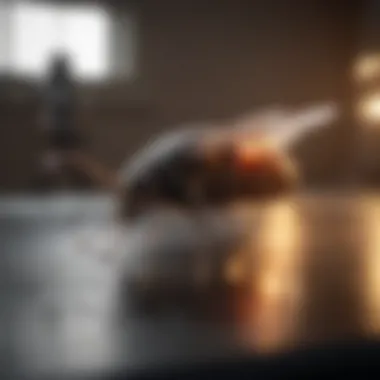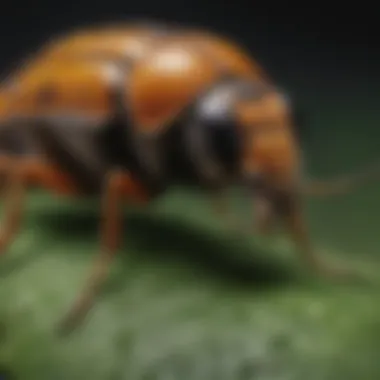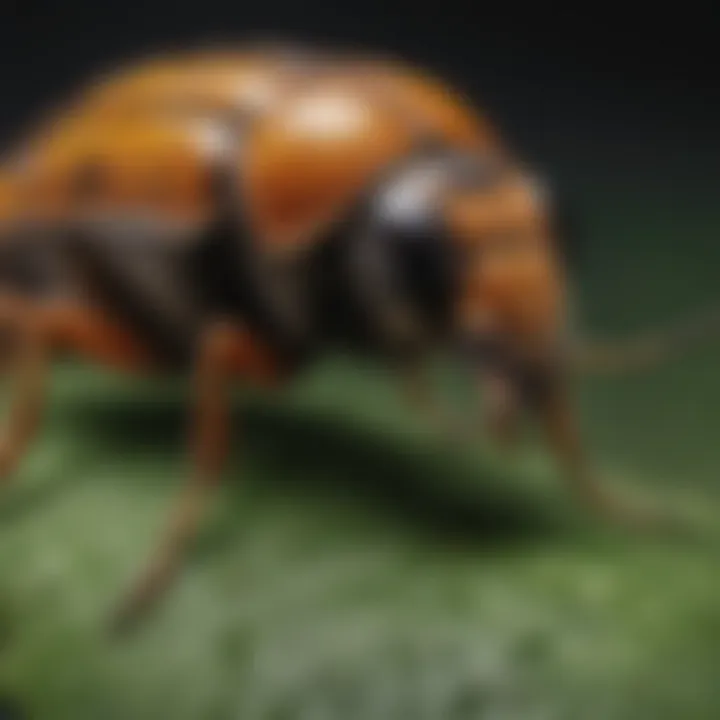Exploring Bright Pest Solutions: Effective Strategies


Intro
Pest management has become an essential topic for homeowners, especially in today's world where ecological balance is crucial. Bright Pest Solutions offers various strategies tailored to address these needs effectively. Understanding pests and their behaviors is the first step. This guide serves as a resource to help you navigate the intricate world of pest management.
Understanding the Pest
Identification
Identifying pests correctly is fundamental. Common types include insects such as ants, roaches, and termites. Each type has unique characteristics that signify its presence. For instance, ants tend to leave behind a pheromone trail, while termites may cause noticeable wood damage.
- Ants: Look for small, black or red insects that form visible trails.
- Cockroaches: Notable for their flat bodies and quick movements, often found in kitchens.
- Termites: Look for discarded wings near windowsills or mud tubes on walls.
Life Cycle
Understanding the life cycle of pests aids in effective management. For example, the life cycle of the common housefly includes egg, larva, pupa, and adult. Each stage presents different challenges. During the larva stage, flies can be particularly damaging to food sources.
Informative Insight
"Knowledge of a pest's life cycle allows for targeted interventions at crucial stages, minimizing their impact."
Pest Prevention Strategies
Environment Modification
A proactive approach can significantly reduce pest activity. Modifying environments minimizes breeding grounds. Simple actions include:
- Eliminating standing water: Check for clogged gutters and other stagnant water sources.
- Removing food sources: Keep food stored tightly and regularly clean surfaces.
Physical Barriers
Physical barriers are effective in keeping pests out. Installing door sweeps and window screens can deter entry. Sealing cracks and crevices in walls and foundations also plays a vital role. Every tiny opening can become an entry point for pests.
Control Methods
Chemical Control
Chemical methods should be approached with caution. They may include insecticides and repellents. These products require careful application to prevent adverse effects on the environment. Always follow the recommended usage guidelines to ensure safety.
Biological Control
Biological control involves using natural predators. For example, ladybugs can control aphid populations. Utilizing these natural methods can be effective and more ecologically friendly.
Prolusion to Bright Pest Solutions
Pest management is an issue that affects families and communities globally. Understanding Bright Pest Solutions is essential for homeowners who want effective and responsible pest control options. This introduction aims to delineate the concept and implications of such solutions in enhancing households' living conditions while being mindful of the environment.
Defining Bright Pest Solutions
Bright Pest Solutions encompasses a range of methods and practices aimed at controlling and preventing pest infestations in a responsible manner. These solutions are not just about eradication; they focus on achieving long-term results by minimizing the use of harmful chemicals and fostering ecological balance. In essence, Bright Pest Solutions seeks to combine efficacy with sustainability, ensuring that both immediate and future pest issues are addressed without compromising environmental integrity.
Several key principles underpin this approach:
- Prevention: Taking proactive steps is crucial. Regular home inspections help identify potential pest problems before they escalate.
- Education: Homeowners should be well-informed about common pests and their behaviors. Knowledge allows for better decision-making.
- Responsibility: Utilizing methods that do not harm beneficial insects or the environment demonstrates a commitment to ecological stewardship.
The Importance of Innovative Pest Management
Innovative pest management techniques play a pivotal role in modern pest control strategies. The significance of these methods lies in their ability to address pest issues effectively while promoting sustainability. Homeowners increasingly seek solutions that are not only efficient but also environmentally sound.
Using innovative methods can yield several benefits:
- Enhanced Effectiveness: Modern technologies, such as smart pest management systems, improve monitoring and response times to infestations.
- Reduced Chemical Use: Many innovations minimize reliance on harmful pesticides, which can have residual effects on the environment and human health.
- Tailored Solutions: New approaches allow for customizing pest management strategies based on specific infestations, leading to better outcomes.
In summary, innovative pest management is crucial for anyone seeking to maintain a pest-free home responsibly. By embracing these methods, homeowners can safeguard their living spaces while contributing to broader ecological conservation efforts.
Understanding Pest Behavior
Understanding pest behavior is essential for effective pest management. Knowledge of how pests live, grow, and reproduce provides insight into how to prevent infestations and reduce their impact. When homeowners are aware of common habits and locations of pests, they can take proactive measures. This section covers critical aspects of pest behavior, focusing on common pest species and their habits, as well as the triggers that lead to infestations.
Common Pest Species and Their Habits
Different pests have distinct behaviors and patterns. Here are several common ones:
- Ants: Ants are social insects that live in colonies. They can be found indoors searching for food and water, which prompts them to invade kitchens and pantries. Understanding their trails can help identify entry points.
- Cockroaches: These pests are primarily nocturnal and prefer dark, moist places. They often hide behind appliances or in cabinets. Their habits may indicate unsanitary conditions, as they seek out food remnants and moisture.
- Termites: Termites can be destructive, feeding on wood and other cellulose materials. They often go unnoticed until significant damage has occurred. They create mud tubes for travel when searching for food.
- Bed Bugs: Bed bugs are notorious for their ability to hide in small crevices, particularly in mattresses and bed frames. Their behavior involves nocturnal feeding on humans, leaving behind itchy bites that can indicate their presence.
Learning the habits of these pests can lead to effective prevention strategies. It allows homeowners to identify signs of infestations early and take necessary actions.
Triggers for Pest Infestation
Several factors may trigger a pest infestation. Recognizing these triggers is vital for maintaining a pest-free environment. Key triggers include:
- Food Availability: Accessible food sources can attract pests. Unsealed food items or crumbs can invite rodents, ants, and other pests into homes.
- Water Sources: Pests need water to survive. Leaky pipes or standing water can provide the moisture required for pests such as mosquitoes and cockroaches.
- Shelter: Pests seek protection from the elements and predators. Clutter and hidden areas in the home may offer prime real estate for pests to nest and reproduce.
- Seasonal Changes: Pests tend to invade homes more frequently during certain seasons, particularly in spring and fall. Changes in temperature can compel insects to seek warmth indoors.


Homeowners who understand these triggers can take practical steps to eliminate conditions that favor infestations. Simple practices, such as proper sanitation, sealing entry points, and mindful landscaping, can greatly reduce pest-related issues.
It's crucial for every homeowner to recognize their environment's influence on pest behavior. Understanding pests leads to better control.
Eco-Friendly Pest Control Methods
The shift towards eco-friendly pest control methods stems from a growing recognition of environmental impact. Homeowners today seek ways to manage pests that do not harm the ecosystem, pets, or their family's health. Eco-friendly methods focus not only on effectiveness but also on sustainability, ensuring that pest management contributes positively to the environment rather than detracting from it.
Some benefits of eco-friendly pest control include:
- Reduced Chemical Exposure: Using natural methods minimizes harmful chemicals around the home. This not only protects children and pets but also reduces pollution.
- Biodiversity Protection: Eco-friendly strategies often enhance local biodiversity by avoiding toxic substances, thereby preserving beneficial insect species that contribute to the ecosystem.
- Cost-Effectiveness: Many eco-friendly solutions utilize common items available around the house, providing a budget-friendly option for pest management.
- Long-Term Solutions: These methods often address the cause of pest problems rather than just treating the symptoms, leading to effective long-term pest control.
In summary, integrating eco-friendly pest control methods is essential for responsible management. It reflects a commitment to sustainable practices that foster healthier living conditions.
Biological Control Strategies
Biological control employs natural predators, parasites, or pathogens to manage pest populations. This method is inherently sustainable, as it uses existing ecological relationships rather than introducing new chemicals to the environment.
For example, ladybugs are released into a garden to consume aphids, effectively controlling their numbers. Another common biological control agent is the nematode, which targets specific soil-dwelling pests and reduces their population without harming beneficial insects.
The effectiveness of biological control strategies rests on selecting the right organisms to target specific pests. It requires an understanding of the pest's life cycle and habits. Important considerations include ensuring that the introduced species won’t become pests itself and that environmental conditions support the biological agents’ survival. This method showcases a balanced approach to pest management, enabling home and garden owners to maintain a healthy ecosystem while controlling pest populations effectively.
Biological control must be used thoughtfully to maintain harmony in the ecosystem.
Natural Remedies and Repellents
Natural remedies for pest control have gained popularity due to their accessibility and ease of use. These remedies often consist of essential oils, household ingredients, and plant-based solutions, reducing the need for chemical treatments.
Some effective natural remedies include:
- Diatomaceous Earth: This substance disrupts the exoskeleton of insects, leading to dehydration and death. It is safe for humans and pets but lethal to pests.
- Essential Oils: Oils like peppermint and lavender act as natural repellents, deterring various pests without harmful side effects. Spray diluted solutions around entry points to keep pests at bay.
- Vinegar Solutions: A mixture of vinegar and water can repel ants and spiders. It is easy to make and non-toxic.
- Soap and Water: A simple solution can kill soft-bodied insects like aphids. Regular application helps control populations effectively.
These methods provide an attractive alternative for homeowners looking to maintain a pest-free environment while prioritizing health and environmental considerations. By combining various natural remedies, one can create a comprehensive pest management approach that respects both efficacy and ecology.
Chemical Control Techniques
Chemical control techniques remain a focal point in effective pest management. They address various pest issues where other methods may fall short. Chemical methods can target specific pests with precision, often promoting rapid results. With the ongoing challenges posed by pest populations adapting, it becomes critical to understand how these chemicals work and their rightful place in a balanced pest management strategy.
There are specific chemicals designed for various pest issues. When considering the application of these methods, it is essential to evaluate both the effectiveness and potential risks. Homeowners should always aim for a method that reduces health risks to people and pets while maintaining a pest-free environment. Thus, understanding the benefits and considerations of using chemical control methods is key to responsible pest management.
Insecticides: Types and Applications
Insecticides are a mainstay in pest control, offering targeted solutions for different types of infestations. Generally, insecticides can be categorized into two primary types:
- Contact insecticides: These are applied directly to pests and affect them upon contact. They work quickly but may require precise application to be effective.
- Systemic insecticides: These are absorbed by the plant and act from within, affecting pests that consume parts of the plant. They provide longer-lasting protection, making them suitable for more persistent infestations.
When selecting insecticides, consider the specific pest problem. For example, pyrethroids are commonly used for household pests, while neonicotinoids might be chosen for agricultural applications, as they disrupt the nervous system of insects. Understanding the appropriate contexts for their use can lead to better pest control outcomes.
Safety Precautions with Chemical Treatments
Employing chemical treatments demands a strong emphasis on safety. Misuse of insecticides can lead to adverse effects, not only on pests but also on humans and the environment.
To ensure safe application, homeowners should heed the following precautions:
- Read Labels Carefully: Always follow the manufacturer's instructions, which outline the correct dosage, application method, and safety precautions.
- Protective Gear: Use gloves, masks, and goggles when applying chemicals to protect your skin and respiratory system.
- Ventilation: Ensure that the area is well-ventilated during and after application to disperse potentially harmful residues.
- Storage: Store chemicals away from children and pets, and ensure they are kept in a secure location to prevent accidental exposure.
"Safety first, pest elimination second. Effective pest management requires respect for both the environment and human health."
By integrating safety precautions, chemical control techniques can be utilized effectively and responsibly, allowing society to benefit from the advancements in pest management while reducing harmful impacts.
Integrated Pest Management (IPM)
Integrated Pest Management (IPM) is a sophisticated approach to controlling pests that underscore the significance of ecological balance and prevention. This methodology prioritizes understanding the complex interactions between pests, their environments, and the various methods of control available. By adopting IPM practices, homeowners can minimize the reliance on chemical treatments, thereby enhancing environmental health and reducing potential harm to non-target species, including beneficial insects and humans.
Furthermore, IPM emphasizes a holistic view of pest management. It avoids a one-size-fits-all solution. Instead, it promotes tailored strategies that consider the specific conditions and requirements of each situation. For instance, identifying the pest species present, understanding their life cycles, and recognizing their natural predators is crucial. This knowledge informs decisions about the most appropriate control methods, fostering efficiency and sustainability.
Principles of IPM
The underlying principles of IPM rest on informed decision-making and proactive monitoring. Each principle guides homeowners towards developing a more mindful pest management strategy. Critical principles include:
- Prevention: Focus on preventing pest infestations by maintaining a clean environment, sealing entry points, and managing landscaping effectively.
- Monitoring: Regularly assess pest populations and environmental conditions to ensure timely intervention.
- Identification: Accurately identifying the pest allows for specific control measures, which is more effective than blind application of treatments.
- Control Measures: Employ a combination of biological, cultural, mechanical, and, if necessary, chemical methods in a strategic manner.
By adhering to these principles, homeowners can foster a balanced ecosystem around their residence.
Implementing an IPM Plan at Home
Creating and implementing an IPM plan within the home involves several systematic steps. Each step is designed to ensure comprehensive and sustainable pest control:
- Assessment: Begin with a thorough inspection of the home and surrounding areas. Look for signs of pests and identify potential entry points.
- Setting Thresholds: Establish action thresholds to determine when pest populations warrant intervention. This could be based on aesthetic value or health concerns.
- Choose Management Strategies:
- Implementation: Apply the chosen strategies consistently and according to established guidelines. Monitor their effectiveness continually.
- Evaluation: After implementation, regularly assess the situation. Adjustments may be necessary based on the outcomes and continued monitoring.
- Opt for non-chemical methods first, such as traps for rodents or barriers for insects.
- If chemical interventions become necessary, select targeted products that are least harmful to beneficial organisms.
By following these steps, homeowners enhance their pest management efforts, promoting a harmonious relationship with the environment.


"IPM is not just about controlling pests; it is about understanding our interactions with surrounding ecosystems and managing them in a way that promotes ecological balance."
Through IPM, households can protect their living spaces effectively while contributing to overall environmental welfare.
Technological Advancements in Pest Control
Technological advancements in pest control are transforming the way homeowners and professionals approach pest management. These innovations aim not only to enhance effectiveness but also to minimize environmental impact. Utilizing technology can lead to more precise treatments, improved monitoring, and a better understanding of pest behaviors. This section explores two noteworthy advancements that are shaping pest control strategies today.
Smart Pest Management Systems
Smart pest management systems are changing how we deal with infestations. These systems rely on IoT (Internet of Things) technology to monitor pest presence and activity in real time. Sensors can detect temperature, humidity, and movement, providing critical data to homeowners. This allows for more targeted interventions rather than blanket treatments.
The benefits of smart systems include:
- Real-time Monitoring: Homeowners receive instant alerts on pest activity, enabling swift action before infestations grow.
- Data Analysis: Systems analyze data over time, revealing trends that help predict when and where pests are likely to appear again.
- Eco-friendly Solutions: By using data to apply pest control only when necessary, these systems help reduce chemical use and environmental harm.
Implementation often requires an initial investment, but the potential savings in both pest control costs and environmental impact are significant. More data-driven approaches can yield more effective results, making these systems a worthwhile consideration for serious pest management.
Use of Drones in Pest Monitoring
Drones are emerging as valuable tools in pest monitoring, especially for larger properties and agricultural fields. They provide a bird’s-eye view that can be instrumental in identifying pest hotspots. This technology not only enhances monitoring but also offers greater accessibility to hard-to-reach areas.
The advantages of using drones in pest control include:
- Visual Inspection: Drones can capture high-resolution images to identify infested areas discreetly and accurately.
- Rapid Assessment: Compared to traditional methods, drones can cover extensive grounds in less time, allowing for quicker decision-making.
- Data Collection: Many drones come equipped with sensors that can collect data on plant health, informing both pest management and crop health strategies.
Role of Beneficial Insects
Beneficial insects play a crucial role in pest management strategies. They contribute to naturally reducing pest populations in gardens and landscapes, promoting a balanced ecosystem. Understanding how these insects operate is essential for anyone interested in sustainable gardening or pest control methods. By harnessing the power of beneficial insects, homeowners can minimize the use of chemical pesticides and create a healthier environment.
Predators and Parasitoids
Predators and parasitoids are categories of beneficial insects that target harmful pests. Predators, such as ladybugs and lacewings, feed directly on pests like aphids and caterpillars. They can significantly decrease pest populations when introduced into an environment. These insects reproduce quickly, creating a stronger defense against future infestations.
Parasitoids, on the other hand, are insects that lay their eggs inside or on a host pest. The larvae consume the host, effectively controlling pest numbers. An example includes various species of wasps that target caterpillars or beetles. Utilizing these insects in pest management can lead to long-lasting results in controlling specific pest populations.
"Incorporating beneficial insects into your pest management plan can reduce reliance on synthetic pesticides, promoting an eco-friendly approach to gardening."
Homeowners can attract these beneficial insects by planting a diverse array of flowers and plants. Consider including nectar-rich plants that bloom at different times of the year to provide a constant food source. Plants like marigold, dill, and fennel are excellent choices for attracting these helpful insects.
Pollinators and Their Importance
Pollinators, such as bees and butterflies, are essential for maintaining plant health and diversity. They assist in the reproduction of many flowering plants, which contributes to a balanced ecosystem. While pollinators are not typically used in direct pest control, their presence enhances the overall health of gardens, indirectly reducing the likelihood of pest issues.
By fostering a habitat for pollinators, homeowners can encourage natural pest control. A healthy garden environment is less prone to pest infestations due to increased plant vigor and better resilience. It is important to avoid pesticides that harm these beneficial insects, as their decline can lead to greater pest problems in the long run.
Homeowners can support pollinators by planting native species and providing water sources. Minimizing chemical inputs further ensures these vital insects thrive, benefiting the overall garden environment. Encouraging pollinators is a key element in sustainable gardening practices.
Homeowners and housewives can integrate these beneficial insects into their gardening practices. By prioritizing ecological balance, they can achieve an enjoyable and productive garden while maintaining pest problems at bay.
Residential Pest Control Solutions
Residential pest control solutions are crucial for maintaining a healthy and comfortable living environment. Pests can bring a variety of issues, including health risks, property damage, and emotional distress. Effective pest management strategies ensure that homes remain pest-free while also considering sustainable practices that do not harm the environment. Homeowners must familiarize themselves with various methods for dealing with pests, as well as their respective advantages and potential drawbacks.
It is important to understand the specific pest problems one may face. Common pests such as ants, termites, and cockroaches have diverse behaviors and habitats, making tailored management essential. Homeowners should also consider preventive measures that reduce the likelihood of infestations, such as maintaining proper sanitation and sealing entry points.
DIY Pest Control Techniques
Do-It-Yourself (DIY) pest control techniques are increasingly popular among homeowners who seek to address pest issues without the cost of professional services. These methods can be cost-effective and empower residents to take control of their environment. Simple actions such as cleaning regularly and using barriers can yield significant results.
Several DIY pest control strategies include:
- Vinegar and Water Solutions: Vinegar is a natural pest deterrent. Mixing equal parts of vinegar and water can create a spray that repels insects like ants and spiders.
- Essential Oils: Certain oils, such as peppermint and tea tree oil, have proven effective in repelling pests. Diluting these oils with water creates a natural insect repellent.
- Traps: Homemade traps using common household items can be effective for capturing pests. For example, dish soap and water can attract and incapacitate fruit flies.
Before using DIY methods, homeowners should ensure they fully understand the pest they are targeting. This knowledge prevents misapplication and enhances the effectiveness of the chosen technique.
"Education on pest identification can significantly improve DIY pest control success rates."
Choosing Professional Pest Control Services
Sometimes, the scale of a pest issue may necessitate professional intervention. Choosing the right professional pest control service is an important decision that can make a significant difference in the effectiveness of pest management efforts. Several factors should be considered during this process.
Firstly, researching the reputation of pest control service providers helps ensure quality and reliability. Homeowners can read reviews online, check for accreditation, and ask for referrals from friends or family. Certifications indicate the company meets industry standards for safety and effectiveness.
It’s also essential to evaluate the specific services offered. Some companies may offer environmentally friendly pest control solutions, which can align better with homeowners’ preferences for sustainable methods. Additionally, understanding the company’s approach to pest control—such as whether they use Integrated Pest Management (IPM) principles—can affect long-term success.
Lastly, consider the cost of services compared to the expected results. While it is necessary to stay within a budget, opting for the cheapest option may alone not guarantee effective results. It’s important to strike a balance between cost and quality when selecting a pest control provider.
In summary, effective residential pest control involves a combination of DIY techniques and professional services. Homeowners must stay informed and proactive to keep their living spaces safe and comfortable.
Gardening and Pest Management
Gardening is essential for many homeowners, providing beauty, fresh produce, and a connection to nature. However, it also attracts various pests that can threaten plant health and productivity. Understanding gardening and pest management is vital for maintaining a thriving garden while minimizing ecological disturbance. By applying effective pest management techniques, individuals can protect their plants and ensure a sustainable gardening experience.


One significant aspect of gardening is recognizing the delicate balance between fostering plant growth and controlling pests. Unchecked pest populations can lead to substantial damage, affecting not just single plants but entire gardens. Therefore, a proactive approach that includes monitoring and management can help in preventing infestations before they become severe. This balance enhances both the aesthetic and productive qualities of a garden.
Protecting Plants from Insects
The threats that insects pose to gardens require vigilant protective measures. Pests like aphids, spider mites, and caterpillars can devastate plants if not addressed promptly.
Here are some strategies to protect plants effectively:
- Regular Inspection: Frequent checks for signs of pest activity can help catch infestations early. Look for discoloration, wilting, or small holes in leaves.
- Physical Barriers: Using row covers or insect netting can deter pests while allowing light and moisture to reach plants.
- Hygiene and Maintenance: Keeping the garden tidy by removing dead plants and weeds helps prevent pest habitats.
- Natural Predators: Encourage beneficial insects, such as ladybugs and lacewings, that prey on harmful pests.
"Maintaining vigilance and adapting pest control methods based on real-time observations is crucial in an effective gardening strategy."
Implementing these methods can greatly decrease pest pressure and support a robust and healthy garden.
Companion Planting as a Strategy
Companion planting is a gardening technique that involves pairing certain plants to enhance their growth, deter pests, or attract beneficial insects. This strategy is advantageous because it promotes biodiversity and reduces a garden's reliance on chemical treatments.
Benefits of companion planting include:
- Pest Deterrence: Some plants can repel pests. For example, marigolds are known for repelling nematodes and aphids.
- Improved Pollination: Certain flowers attract pollinators, which can enhance the productivity of nearby fruit and vegetable plants.
- Soil Health: Diverse root systems can improve soil structure and fertility, promoting overall health.
- Space Optimization: Growing complementary plants together can maximize space and nutrient use efficiency in the garden.
Community Engagement in Pest Management
Community engagement plays a crucial role in effective pest management strategies. It fosters collaboration between residents, local businesses, and various organizations focused on pest control. This collective effort not only enhances the effectiveness of pest management practices but also encourages sustainable practices that benefit the entire community.
Engaging community members helps in sharing knowledge and resources. When people work together, they can exchange information about pest behavior, prevention strategies, and control methods. This shared knowledge becomes a critical component in developing a localized approach to manage pests effectively.
Moreover, community engagement leads to the identification and addressing of specific pest issues that may be prevalent in a given area. Involving local residents can enhance awareness about prevalent pest species and their control. The proactive nature helps in reducing the need for reactive measures later. Educational initiatives can prevent the reliance on harmful chemicals, promoting a more eco-friendly environment.
Educational Workshops and Resources
Organizing educational workshops is an effective strategy for community engagement in pest management. These workshops can provide residents with the knowledge they need to manage pests effectively and responsibly. Participants can learn about various pest control methods, both chemical and non-chemical.
Such programs often include guest speakers, demonstrations, and hands-on activities that allow attendees to practice techniques. They can learn how to identify common pests, understand their habits, and discover appropriate prevention methods. The workshops effectively empower homeowners, helping them to take control of their pest problems with confidence.
In addition, providing resources such as brochures, online materials, and local guides can reinforce the information shared during these workshops. Community members can reference these materials as needed, ensuring they have ongoing access to vital pest management information.
"Education is the key to improving community health and environmental sustainability, especially in managing pests." – Pest Management Resource Center
Building Community Awareness
Building community awareness about pest management creates a more informed public. This can involve utilizing various channels such as social media, community meetings, and local events. By sharing information about the importance of pest management and how community members can contribute, awareness can significantly increase.
Moreover, creating campaigns that highlight the risks associated with pest infestations can motivate residents to participate in educational sessions and community initiatives. Distributing flyers and utilizing social media platforms, such as Facebook and Reddit, can effectively spread awareness. Engaging with community groups makes this process more significant.
Community leaders can help facilitate these discussions, making it easier for residents to voice their concerns and suggestions. Encouraging participation in local pest monitoring programs can also help track the effectiveness of implemented strategies.
The Future of Pest Control
The future of pest control is shifting towards more sustainable and integrated approaches. This transition is crucial as homeowners and professionals recognize the need for solutions that protect both property and the environment. By understanding emerging trends, pest management can be refined to meet modern challenges effectively and responsibly. The emphasis is on innovation, responsibility, and environmental consciousness in managing pest populations.
Emerging Trends in Pest Solutions
Recent advancements in technology and science have revolutionized pest control practices. Here are some key trends:
- Smart Technology: The use of smart traps and sensors allows for real-time monitoring of pest activity. These devices can alert homeowners when intervention is needed, minimizing the use of chemicals.
- Eco-Friendly Products: There is an increase in awareness about harmful chemicals. Thus, companies are developing biodegradable and non-toxic pest control options. These products ensure safety for pets and children while effectively managing pests.
- AR and VR in Training: Augmented and virtual reality technologies are now being used for training pest control professionals. This immersive experience equips technicians with better skills than traditional methods.
- Data Analysis: Big data helps in identifying pest patterns. By analyzing data from various sources, pest management professionals can predict infestations and respond proactively.
These trends reflect a commitment to effective pest management while prioritizing safety and sustainability.
Sustainable Practices for Coming Generations
Sustainability is a critical aspect of future pest control methods. Here are some sustainable practices that can be adopted:
- Integrated Pest Management (IPM): This holistic approach combines different strategies to manage pests effectively with minimal environmental impact. IPM practices include cultural, biological, and mechanical control methods.
- Environmental Stewardship: Homeowners can contribute by maintaining their gardens and yards in ways that minimize pest attraction. This includes promoting healthy plants and reducing standing water to deter mosquitoes.
- Community Involvement: Educating neighbors and engaging in community clean-up initiatives can significantly reduce pest populations. Creating awareness about sustainable practices ensures a collective effort towards effective pest management.
- Selective Chemical Use: When chemical controls are necessary, using targeted applications can reduce harm to beneficial organisms. Practicing precision in chemical application is essential.
- Regular monitoring for pests helps in early detection.
- Employing beneficial insects to control pest populations is a natural method to reduce chemical dependency.
By implementing these sustainable practices, society can ensure effective pest control for future generations. By prioritizing safety, environmental impact, and community health, the future of pest management looks promising and responsible.
The future of pest control lies not just in managing pests effectively, but also in maintaining ecological balance for generations to come.
Ending
The conclusion serves as a pivotal part of the article, bringing together various strands of information explored throughout. This section reinforces the significance of using effective pest management techniques that ensure ecological balance while also serving practical needs. The insights offered in earlier sections highlight diverse methods and strategies available to homeowners and pest control professionals alike.
Recap of Key Points
As we review key points discussed, a thorough understanding of pest management approaches must be emphasized. The following are crucial elements that deserve attention:
- Definitions and Importance: Understanding the fundamental principles of pest control and the impact that pests can have on our living environments.
- Pest Behavior Insights: Recognizing common pest behaviors and triggers can aid in preventing infestations.
- Eco-Friendly Practices: The value of sustainable methods that protect both home and environment without relying heavily on chemicals.
- Technological Innovations: Awareness of advancements such as smart pest management systems that offer new solutions.
- Community Engagement: The role of educational workshops in promoting awareness and practices within neighborhoods.
- Future Outlook: Understanding emerging trends will ensure that pest management strategies remain relevant and effective.
Encouraging Ongoing Learning and Adaptation
Adaptability in the face of change is essential for both individuals and communities. Pest management is not static; it requires persistent learning and adaptation to new challenges and solutions. Homeowners should regularly update their knowledge about effective pest control practices.
Participating in community workshops, utilizing online resources such as Wikipedia, and engaging with insights shared on platforms like Reddit or Facebook will enhance understanding. Moreover, fostering an environment of shared learning can significantly impact the effectiveness of measures undertaken against pests.
Incorporating ongoing education and community collaboration into pest control efforts can transform not only how pests are managed but also instill a sense of responsibility toward the environment. A proactive approach can lead to long-term solutions that benefit every member of the community.







